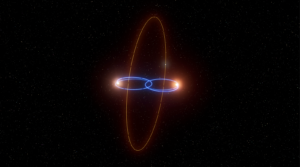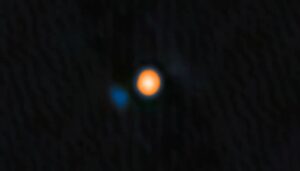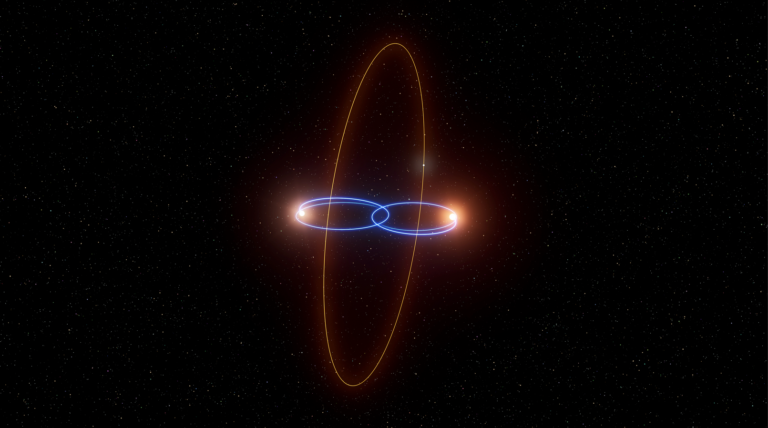When you purchase through links on our site, we may earn an affiliate commission. Here’s how it works.

A radio-wavelength image of the crooked jet beaming out from the supermassive black hole system OJ 287. (Image credit: Dr Efthalia Traianou, Heidelberg University, IWR)
A beam of particles speeding away from the vicinity of a monstrous black hole has been found to be severely kinked, providing compelling evidence that the black hole is actually part of the most extreme binary system known.
The black hole and its crooked jet are found in a blazar known as OJ 287, located about four billion light-years away. A blazar is a quasar seen head-on, and a quasar is the active core of a galaxy where the resident supermassive black hole is pulling in huge amounts of matter. That matter spirals around the black hole, forming what’s called an accretion disk, and there’s so much matter that the accretion disk becomes a bottleneck.
Rather than flowing into the black hole’s maw, the infalling matter piles up in the disk, the density and temperature dramatically increasing such that it shines so brightly that it can be seen across the universe. Magnetic fields wrapped up in the accretion disk are able to funnel some of the charged particles in the matter away from the black hole, collimating them and accelerating them in two opposing jets that blast away from the black hole for thousands of light-years at close to the speed of light. Because we see blazars almost head-on, they appear even brighter than regular quasars.
However, OJ 287 is not your ordinary blazar. Astronomers have been tracking its cycles of brightness variations for about 150 years — from even before they knew what kind of object it is. There’s a long cycle of approximately 60 years, and a shorter cycle with a period of variation of just 12 years.
This short cycle has been attributed to a companion black hole with about 150 million times the mass of the sun orbiting the main black hole, which has been claimed to have a mass equivalent to a whopping 18.35 billion suns. Both black holes are gargantuan compared to Sagittarius A*, which is the 4.1-million-solar-mass black hole at the centre of our Milky Way galaxy.
The less massive black hole moves on an elongated, elliptical orbit. Every 12 years, it plows through the accretion disk of the more massive black hole. As it does so, it steals some of the matter from the disk and forms its own temporary accretion disk, with a temporary jet. For a short time, the OJ 287 system turns into a double quasar.
At least, that’s the hypothesis. Previous observations seem to support the idea. For example, in 2021, as predicted, the OJ 287 system dramatically increased in brightness in just 12 hours as the second black hole encountered the primary’s disk and lit up as a quasar, releasing more energy in that short time than 100 average galaxies put together.







